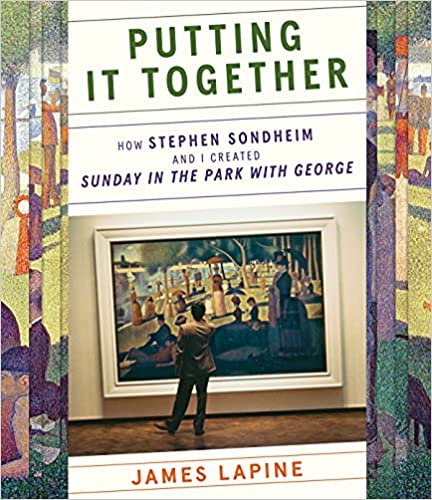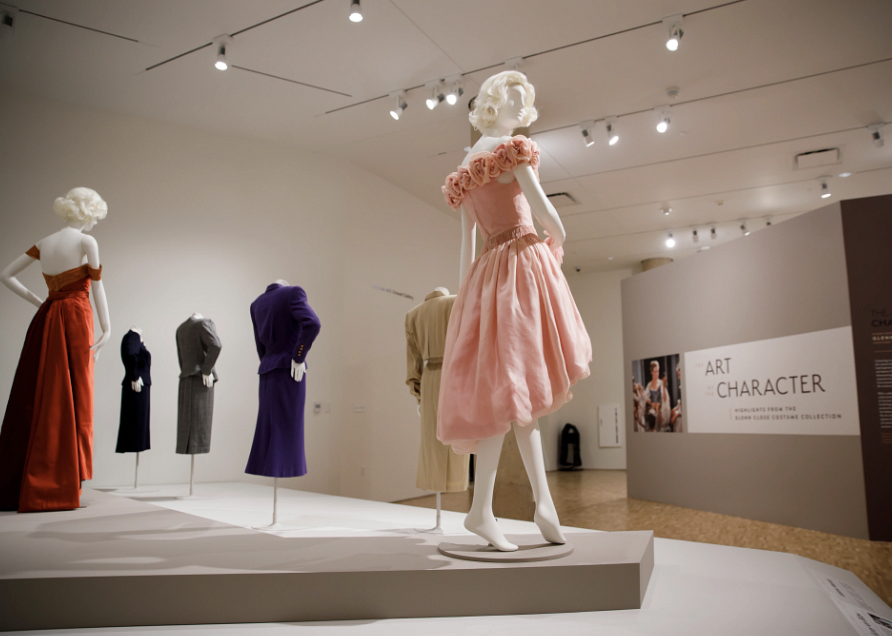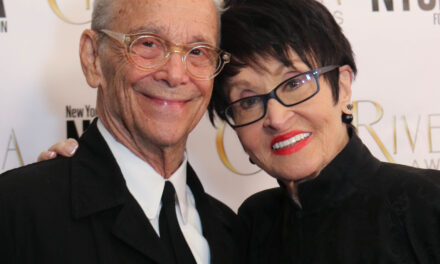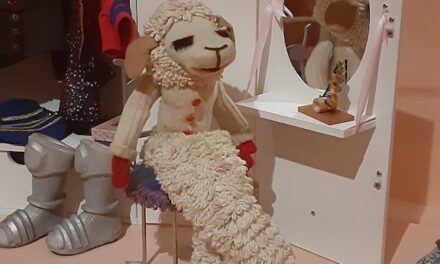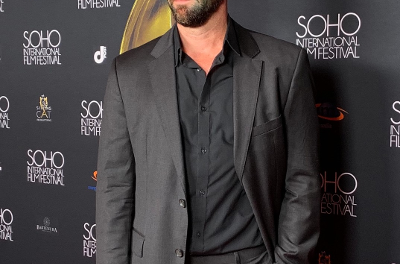By Alix Cohen . . .
Inspired by French pointillist painter George Seurat’s A Sunday Afternoon on the Island of the Grand Jatte, themusical Sunday in the Park with George is unique in its approach, challenges and execution. Who but James Lapine and Stephen Sondheim would see potential in a painting, not only telling a story of the work and painter, but of the process and politics of art/creation?
The one-act version of Sunday briefly ran Off Broadway at Playwrights Horizons. “We were young actors in a tiny, dark theater,” the host recalls, “Bernadette and I shared a dressing room the size of a water closet.” The piece was then expanded to two acts and opened at The Booth Theater May 1984.
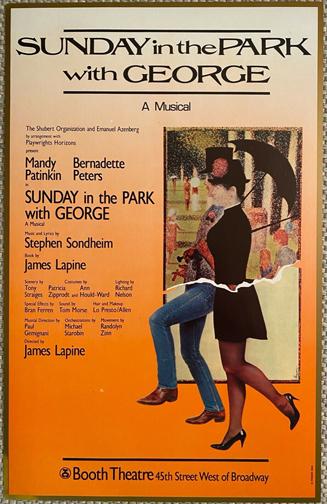
New York Times critic Frank Rich wrote, “Mr. Sondheim and Mr. Lapine have created an audacious, haunting and, in its own intensely personal way, touching work…” Lloyd Rose of The Washington Post called the musical a radically intellectual work, Sondheim, like Seurat, “cold and arrogantly unwilling to please, and the piece “Presentational rather than dramatic.” He quoted the lyric “All head, no heart/No life in his art.”
“Initial audiences were very discouraging,” Sondheim tells us. “I remember the astonished look on James’ face when he saw people walking out, probably for the first time at one of his shows. Lapine watched producer Bernie Jacobs hold the door for exiting audience so it wouldn’t creak.
The unexpected piece won 1985’s Pulitzer Prize for Drama, two Tony Awards, several Drama Desk Awards, the 1991 Olivier Award for Best Musical, and the 2007 Olivier Award for Outstanding Musical Production.
Celebrating publication of librettist/director James Lapine’s book Putting It Together (Farrar, Straus, and Giroux), he and Sondheim review the musical’s development- which was the first of their collaborations. (Into the Woods and Passion are the others.) Conversation is moderated by actress Christine Baranski who was in the Playwrights Horizons production. Original stars, Bernadette Peters and Mandy Patinkin also appear.
Baranski opens this evening by recalling that in 1983, she called the workshop “Lapine leading the blind,” eliciting chuckles from the collaborators. She asks the author about impetus for the book so many years later. Apparently a chance social encounter with the editor of Farrar, Straus, and Giroux sparked the idea. Lapine interviewed dozens of original participants deriving new perspective. Unflattering opinions are included.
When veteran Stephen Sondheim opened his door to young playwright James Lapine, the former was still winded from disastrous receptionto Merrily We Roll Along and his visitor was familiar only with a single Sondheim work, Sweeney Todd. ‘Not, one might assume, an auspicious beginning. Sondheim offered Lapine a joint and the two talked about Bunuel films. They hit it off. Respect and affection palpably runs through this evening.
Lapine had arrived with the idea to adapt a Nathanial West novel which was, in essence, Candide, a musical he didn’t know existed. Paging through art books in search of something else that might spark interest, Lapine and Sondheim came across A Sunday Afternoon on the Island of the Grand Jatte. “…and James said, yeah, but the main character (Seurat) is missing. A light went on,” Sondheim remarks. They talked. And talked. And talked. Lapine wrote.
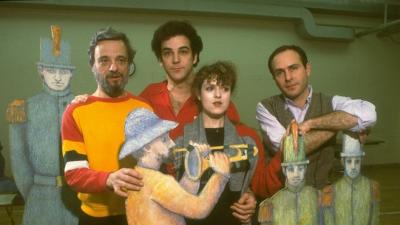

“When did the first piece of music come into the process?” Baranski asks. “Seurat had a palette of 12 colors and there are 12 notes in a scale. I was intrigued by that and started with the arpeggio,” the composer/lyricist tells us. At his collaborator’s request, James wrote a (5 page) monologue for Dot at the top of the show which gave Sondheim musical and verbal language that set the tone for the rest of the score.
Lapine began exploring characters. He laid tracing paper over figures in the painting, labeling them ‘mother’, ‘lawyer’…and took Sondheim to observe an artist at work. Though the painting was abstract, Sondheim tells us he picked up the “dub, dub dub” used in Seurat’s evocative lyric.
Baranski notes that some of the best descriptions in the book are about songs going in at the last moment. “I’ve always said that the best way to write a musical is if it’s cast and on the stage,” Sondheim comments. Patinkin learned “Finishing the Hat” in lightening speed, then crossed the street to try it out at The Laurie Beechman (downstairs at West Bank Café.) Later this evening, the actor notes it was his best performance of the song. “Like falling in love for the first time.”
Out of town try-outs were traditional. Sondheim revels in the Off Broadway experience which takes pressure off productions and increases focus. Lapine says this particular first version came together quickly. “People were brave,” he tells us, his voice rising an octave on the last word. And invested. “Do you think it’s possible to be that fearless today?” Baranski inquires.
Lack of privacy is discussed. The internet spreads everything fast. By the time it headed for Broadway, Sunday was “swimming upstream.” Theater parties booked previews. Word went out before the production had completely settled. Sondheim conjectures that people came in support of a charity, not to see the show. “Criticism while you’re still working on something can affect the work. You have to be careful not to bend to feedback.”
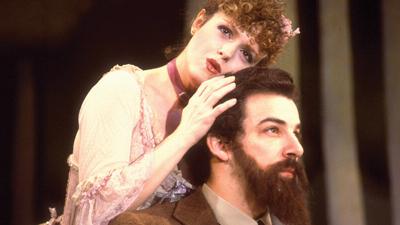

Patinkin, who played Seurat, remembers Lapine addressing the company. “Believe in the work we’ve done, what we’ve made,” he’d said. The actor chokes up. “I take that with me every day. That young man gave that to me when I was 32 years old. You can’t ask for more.” Lapine counters that he felt he was begging. “I knew as a director I had to just let go. They were now claiming ownership as much as Steve and me.”
Bernadette Peters (Dot) and Patinkin had great chemistry and generosity towards one another. “I was and am a terrified human being,” Patinkin tells us. “She held me with kindness creating a kind of freedom. Showing up and being with that kind of actor – she did 90% of the job.” “That’s magnanimous of you, but it works both ways and was very important to this show,” Sondheim observes.
When asked to contribute to an interview about Peters years later, Patinkin refreshed his memory by listening to the cast recording of Sunday. A self-described ‘cry baby’ he burst into tears. “I recognized you can’t experience it when you’re in a play. Like a surgeon, you need to be a step away. As an actor you’re busy fighting for the life of a character. It’s very different in observation.” “That’s what “Finishing the Hat” is about,” Sondheim adds.
Participants collectively recall the extraordinary impact of the end of Act I when Seurat places his characters and the painting comes alive. It is, in fact, a theatrically astonishing moment easy to conjure even so many years later. As voices surge together with “Sunday,” an audience feels exhilarated. In the quiet core of the storm, actors experience it a different way – but definitely feel it.


Lapine and Sondheim address their partnership: A good collaboration is like a marriage…Be open to one another…I think we decided that whoever cares most wins… “The thing that makes theater unique is there’s no finality. It’s possible to go back the next day and try things in front of an audience,” Sondheim says.
Asked about favorite songs, they all interestingly come up with “Move On.” Lapine thinks of the song as a note in a bottle. Peters remembers her character realizing she’ll never be as important to Seurat as his art and resolves to leave. “With “Move On,” she has to release it all.” Lapine says staging eluded them at first. Not allowing the characters to look at one another until the end when they lock eyes, works beautifully. Sondheim appreciatively muses they swayed like palm trees.
Patinkin says that of the score, he performs only “Move On” and “Children and Art” in his solo concerts. “These two songs our gentlemen made are the meaning of life.”
Perhaps the most interesting questions (and answer) afterwards were:
1. “Was any of the score influenced by 19th century French music. “Everything I write is influenced by late 19th, early 20th century French music,” Sondhiem responds… “A lot of Ravel, but here also Benjamin Britten.”
2. What were Lapine’s historical resources? How important was it to be accurate? The project was started without any information at all about George Seurat. “You just know there’s an obsessive guy.” Lapine started to read only after getting into the piece. “He did us a great favor by not leaving anything behind,” Sondheim tells us. “Seurat was a buttoned-up civil servant and very quiet.”


And 3. “What was the thought process behind jumping ahead 100 years?” The original idea was to track the painting’s entire history in a three-act musical,” Lapine says almost wistfully. “It became apparent we couldn’t do that, so we just jumped. It was sold to an American who donated it to The Chicago Art Institute. The painting was rolled up in his attic.”
“I think we wrote the show we wanted to write and were proud of it,” Lapine says in closing. We didn’t set out to write a show everyone would love.” “You can’t and you shouldn’t and it’s not worth the effort,” Sondheim adds.
‘A remarkably illuminating and cogent event.
“James Lapine is a preeminent director, playwright, screenwriter, and librettist. He is the recipient of three Tony Awards for Best Book of a Musical (Passion, Falsettos, Into the Woods), as well as nine Tony Award nominations, five Drama Desk Awards, a Pulitzer Prize in Drama, and a Peabody Award, among other honors. He has also been inducted into the Theatre Hall of Fame and is a recipient of the Mr. Abbott Award for lifetime achievement in theater.
Stephen Sondheim is a composer, lyricist, and Broadway icon. He is the recipient of eight Tony Awards (including a Tony for Lifetime Achievement in the Theatre), a Pulitzer Prize in Drama, an Academy Award for Best Song, eight Grammy Awards, eight Drama Desk Awards, and many other honors. He was awarded the Presidential Medal of Freedom by President Barack Obama in 2015.”
Putting It Together- The Town Hall in partnership with Strand Books
